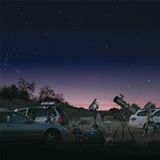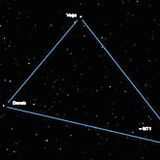
Two of the dimmer constellations, Vulpecula (The Little Fox) and Saggita (The Arrow) are often overlooked. They too, however, contain some excellent and varied deep sky targets, worth an hour or so in the evening before moonrise. These constellations will be placed high in the sky, allowing for the best transparency when viewing the targets we'll visit.
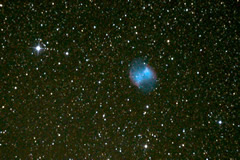
M27 - The Dumbbell Nebula - Image courtesy Lukás Kalista
Let's s start with the most often visited, the famous Dumbbell Nebula planetary nebula. There is no bad view of this target - whether you use a binocular, small wide-field telescope, or magnify it in a larger instrument. It always has something to reveal. And a narrow-band filter such as Orion's Ultrablock, will aid in providing contrast to bring out the finer details. The Dumbbell unfiltered has a roundish shape, appearing as a hazy ball without detail, and will most certainly appear as such in your binocular or small scope. With more aperture though, and using a filter, detail will show, in shape and extent of the object. Note the "apple-core" our hour-glass shape, and the dimmer "bubble" surrounding the core. Can you pick out the faint central star? Star hop there from Alberio in Cygnus to Gamma Satittae - about 3/4 the distance, and sweep slightly north. The Dumbbell is large in apparent size and bright, as it is a relatively close planetary nebula at magnitude 7.5, 1360 light years distant, and 8x5 arcminutes. If you see the central star, you've seen the largest know white dwarf!
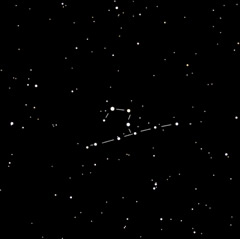
Collinder 399 - The Coathanger
Nearby the Dumbbell is a famous and fun asterism. An asterism is a shape, a figure, that can be seen, within a constellation - that is not a constellation. Examples of an asterism are The Big Dipper (part of the constellation Ursa Major) and The Teapot in the constellation Sagittarius. The asterism we'll view requires a binocular or small telescope to fully enjoy, although it was first noted before telescopes by the Persian astronomer Al Sufi in 964. Its proper name is Collinder 399, but has the popular name of The Coathanger. It is easy to get to from The Dumbbell, about 14-1/2 degrees to its west. When you see it, you'll have no doubt you've found it, the shape is very distinctively a classic coat hanger! You will be able to find this in a 50 mm binocular.
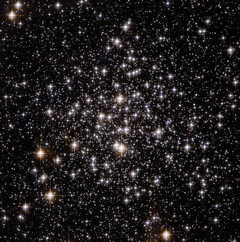
M71 - Hubble Space Telescope image.
Between and below the Coathanger and the Dumbbell Nebula is the small constellation Saggita. It is easy to pick out - its two "arrow feather" stars are close together and the shaft of the arrow form a straight line. Along the shaft you'll find the Globular Cluster Messier 71, visible as a hazy spot in binoculars. This is no ordinary globular. It is loose and was for a long time thought to be an open cluster. By scientifically aging that stars, it was determined they were far too old to be part of any open cluster. It will most likely appear unresolved in your telescope, more of a hazy ball without individual stars being apparent. M71 shines at magnitude 7.2 and is a close globular at only 13,000 light years distant.
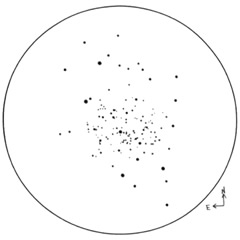
NGC 6940 in Vulpecula is a treat of an open cluster, as it is very rich and easy to locate. We are once again back in the constellation Vulpecula, but at its northern end away from the Dumbbell and Coathanger. There have been reports of this target being seen in binoculars, but a 70mm telescope or lager will provide a more certain and pleasing view. Here is an observation and drawing by of Jaakko Saloranta of Finland in an Orion 8" Dobsonian (courtesy Deepskypedia.com): " A beautiful cluster spotted in somewhat unknown part of the sky. Size at least 25', consisting of roughly 50 stars magnitudes 11-14. Centered and slightly detached towards the 9th magnitude star in the middle. W side a bit richer. Well flanked by four 8th magnitude stars. The cluster is almost centered around the 9th magnitude FG Vul. Slightly concentrated towards the area SW from FG Vul."
Mark Wagner is a life-long astronomy enthusiast and deep sky observer. He has spent the past twenty years popularizing amateur astronomy in the San Francisco bay area through his writing and community building. A past president of the San Jose Astronomical Association, he founded what is now the annual Golden State Star Party in California. Please post if you have comments, questions, sketches or images you've taken of the targets mentioned above.




